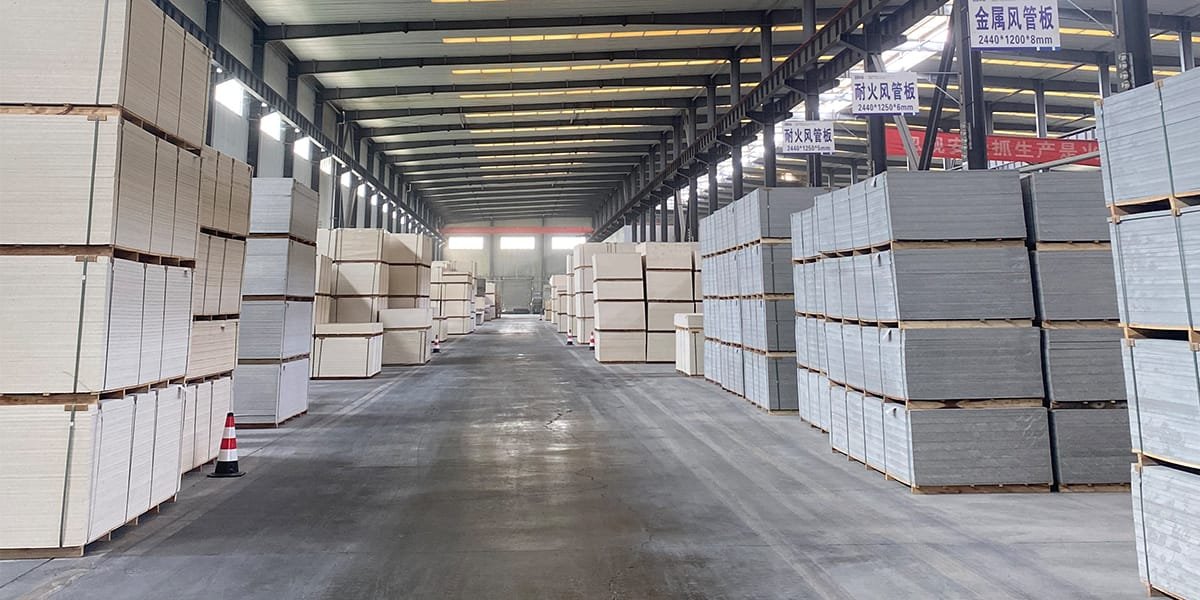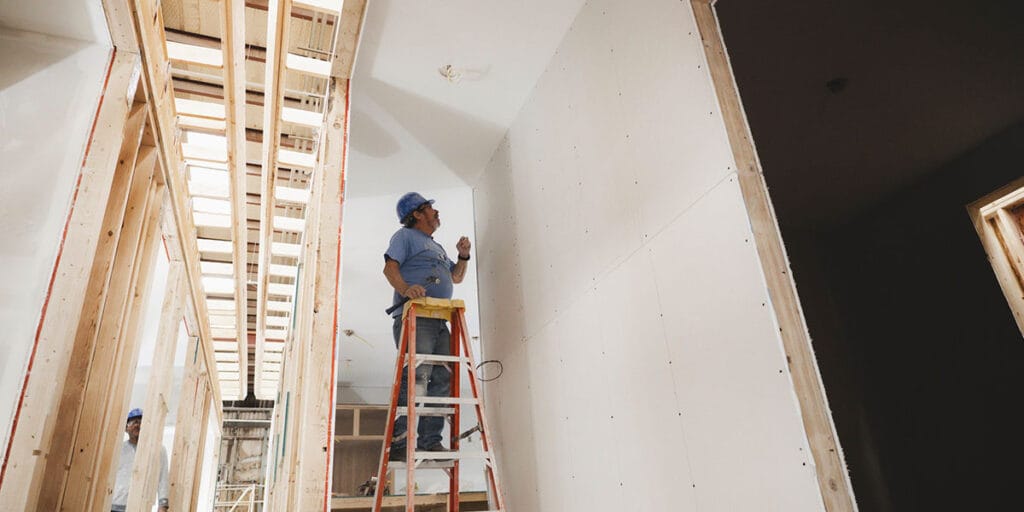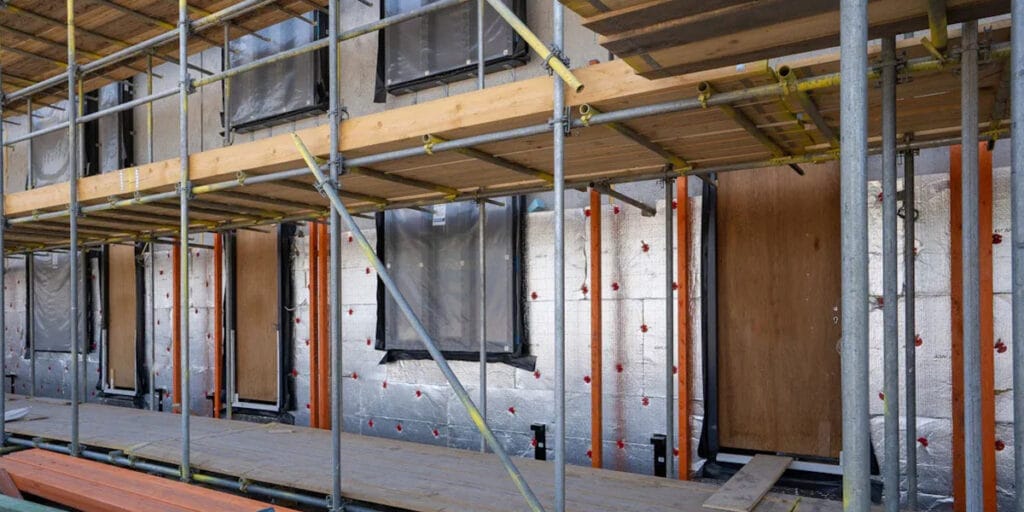
27 Jun Thermal Sheathing Board Options for Sustainable Construction
Table of Contents
Thermal sheathing boards are important for eco-friendly building projects.
They help save energy and lower heating and cooling bills.
You can save up to 40% on energy costs each year.
This could mean saving hundreds of dollars annually.
Insulated sheathing, like 1-inch OX-IS, makes walls much better at keeping heat in or out.
It increases R-value by over 1,100%, making buildings more efficient.
Buildings use about 40% of all energy in the U.S.
Using thermal sheathing can cut this energy use a lot.
This also lets builders use smaller HVAC systems.
Smaller systems cost less but still keep homes comfortable.
Key Takeaways
Thermal sheathing boards can cut energy costs by 40%. They are a great choice for eco-friendly building.
Picking the right thermal sheathing improves insulation. This makes homes more comfortable and lowers energy bills.
Some thermal sheathing, like fiberboard and mineral wool, use recycled materials. This helps protect the environment.
Thermal sheathing can make HVAC systems smaller. This saves money on setup and repairs.
Using materials with high R-values boosts energy efficiency. It meets building rules and helps the planet.
What Are Thermal Sheathing Boards?
Definition
Thermal sheathing boards are special materials used in construction. They help buildings stay warm in winter and cool in summer. These boards stop heat from moving in or out of a building. Builders put them on the outside walls to add a layer of insulation. This setup stops heat from escaping through parts like beams or studs.
There are different kinds of thermal sheathing boards, like foam, fiberboard, and mineral wool. Each type has its own benefits. Some keep heat in better, while others block water or stop drafts. For example, some boards have layers to keep water out, and others make buildings airtight. These features make them important for modern, energy-saving construction.
Importance in Sustainability
Thermal sheathing boards help make buildings more eco-friendly. They improve insulation, which lowers heating and cooling energy use. This saves money on bills and reduces pollution. Studies show that adding insulation outside buildings makes them last longer and use less energy. This design also helps protect the environment.
The building industry now uses thermal sheathing to go green. In 2022, the market for these boards was worth $24 billion. More people want sustainable materials, so the market is growing. Builders use these boards to meet stricter energy rules. Many boards are also made from recycled materials, which helps the planet.
Choosing thermal sheathing makes homes more comfortable and energy-efficient. These boards improve how buildings work and support eco-friendly goals.
Types of Thermal Sheathing Boards
Rigid Foam Boards
Rigid foam boards are a common choice for insulation. They are made from materials like EPS, XPS, or Polyiso. These boards help keep heat inside or outside buildings. This makes homes and buildings use less energy.
Rigid foam boards have a high R-value, which shows how well they insulate. For example:
XPS has about R-5 per inch.
EPS gives around R-4 per inch.
Foil-faced Polyiso ranges from R-6 to R-6.5 per inch.
These boards also resist water, which helps them last longer. Studies show Polyiso boards work well in cold areas. They improve insulation and control moisture. This makes them a good pick for eco-friendly building.
Feature | What It Means |
|---|---|
R-Value | Shows how well the board keeps heat in or out. |
Strength | Measures how much weight the board can handle without bending. |
Water Resistance | Checks how well the board keeps water out, important for long-lasting use. |
Eco-Friendliness | Looks at how the board performs in different environments and its impact on nature. |
If you need strong and flexible insulation, rigid foam boards are a great option.
Structural Insulated Panels (SIPs)
SIPs are panels that combine insulation and support. They have a foam core between two strong boards, like OSB. These panels keep heat from escaping, making buildings more energy-efficient.
Buildings with SIPs cost less to heat and cool. The foam core stops heat from leaking through studs or frames. SIPs are also quick to install, cutting building time by up to 50%. This saves both time and money.
Benefit | Explanation |
|---|---|
Great Insulation | SIPs have a solid foam core that keeps heat from escaping. |
Energy Savings | Homes with SIPs use less energy for heating and cooling. |
Faster Building | SIPs are pre-made, so they save time during construction. |
Strong and Durable | SIPs hold up well under heavy loads and tough weather. |
Better for the Environment | SIPs use less energy to make and create less waste on job sites. |
If you want insulation, strength, and faster building, SIPs are a smart choice.
Fiberboard
Fiberboard is made from wood fibers and is eco-friendly. It provides decent insulation and works well with other materials.
This material lets moisture escape, which prevents mold and mildew. Fiberboard also blocks noise, making it great for homes and offices.
Its R-value is lower than foam boards or SIPs, but it costs less. Fiberboard is a good pick for projects focused on saving money and helping the planet. If you care about sustainability, fiberboard is worth checking out.
Mineral Wool Boards
Mineral wool boards are often used for insulation in green building. They are made from natural or recycled materials like rocks or slag. This makes them eco-friendly and good for the environment. These boards keep spaces warm or cool and reduce noise, making buildings energy-efficient and quieter.
A key feature of mineral wool boards is their fire resistance. They can handle high heat without melting, which makes them very safe. These boards also repel water but let moisture escape, stopping mold from growing.
Research shows moisture and production issues can lower insulation by 40%.
The ability of mineral wool boards to conduct heat changes with conditions:
Condition | Heat Conductivity (W/(m·K)) |
|---|---|
Normal Temperature | |
High Temperature | 0.036 (steady value used) |
Choosing mineral wool boards gives you strong and eco-friendly insulation. They help save energy and make buildings safer and more comfortable.
MGO Sheathing Board

MGO (magnesium oxide) boards are another great choice for green building. These boards are made from magnesium oxide, a natural mineral. They are strong, long-lasting, and resist fire very well.
MGO boards meet many fire safety standards, proving they are reliable:
ASTM E136: Says MGO boards are noncombustible, good for fire-safe buildings.
ASTM E84: Often gets a Class A rating, meaning low flame and smoke spread.
EN 13501-1: Rates MGO boards as A1 non-combustible, so they don’t add to fires.
These ratings show how fire-resistant MGO boards are, making them safe for homes and offices.
Besides fire safety, MGO boards have other perks. They resist mold, mildew, and pests, keeping indoor spaces healthy. They also insulate well, helping save energy.
If you want a strong and eco-friendly material, MGO boards are a smart pick. They offer safety, durability, and environmental benefits for any building project.
Factors to Think About When Picking Thermal Sheathing Boards
R-Value and How Well It Insulates
When picking thermal sheathing, check its R-value. This number shows how well it stops heat from passing through. A higher R-value means better insulation, keeping buildings warm in winter and cool in summer.
How the material works over time is also important. The foam industry uses LTTR (Long-Term Thermal Resistance) to measure R-value over 15 years. This helps ensure the material stays effective. Things like moisture or loss of gases can lower insulation quality. Strong materials avoid these problems and keep their R-value longer.
Rules also stress the need for good insulation. Germany’s EnEv law requires new buildings to meet strict U-value limits, which depend on R-value. In the U.S., the Department of Energy suggests R-values based on climate. For example, colder places need higher R-values to save energy and cut heating costs.
Evidence Type | What It Means |
|---|---|
Long-term R-value Check | LTTR ratings show insulation works well for 15 years. |
Research on Degradation | Moisture and gas loss can lower R-value over time. |
Rules and Standards | Germany’s EnEv law sets U-value limits for new buildings. |
Suggested R-values | U.S. DOE gives R-value advice based on climate and energy savings. |
By knowing about R-value and insulation, you can pick materials that save energy and follow building rules.
Sustainability and Environmental Effects
Sustainability is key when choosing thermal sheathing. Look for materials made from recycled or natural resources. These options cut waste and are better for the planet.
Some boards, like mineral wool and MGO sheathing, use eco-friendly materials. Mineral wool comes from recycled rocks or slag, while MGO boards use magnesium oxide, a natural mineral. These materials insulate well and support green building goals.
Energy efficiency is another thing to think about. Good insulation lowers heating and cooling needs, cutting energy use and pollution. This makes buildings greener and helps fight climate change.
Using sustainable materials matches today’s building trends. More people want eco-friendly construction, and stricter energy rules push for it too. By choosing green materials, you help the planet and meet modern building needs.
Price and Budget
Price matters when picking thermal sheathing. You need to balance upfront costs with long-term savings. Some materials, like rigid foam boards, cost more at first but have high R-values and last longer. These features lower energy bills over time, making them a good investment.
Fiberboard is a cheaper option. It costs less than foam or SIPs but still insulates well. If your budget is tight, fiberboard can save money while meeting basic needs.
Installation costs are also important. SIPs, for example, are pre-made panels that speed up building. Faster construction lowers labor costs, saving money overall.
To choose wisely, compare material prices, insulation quality, and durability. This helps you get the best value for your money.
Compatibility with Building Design
Thermal sheathing boards are flexible and fit many building designs. They work for homes, offices, and factories. These boards match different styles and building methods. They help save energy without hurting the look or strength of your project.
How Thermal Sheathing Boards Fit Diverse Designs
Thermal sheathing boards work well with old and new building styles. They pair nicely with advanced framing, which uses less wood. This method stops heat from escaping through beams or studs. Using thermal sheathing and advanced framing together makes buildings greener and more efficient.
Exterior rigid insulation boards act as insulation and sheathing. They can also serve as drainage planes and vapor barriers. This setup, combined with advanced framing, cuts costs by using fewer materials and creating less waste.
Key Features That Enhance Compatibility
Thermal sheathing boards have features that make them easy to use:
Multi-functional Layers: Some boards insulate, block vapor, and drain water. This reduces extra materials and speeds up building.
Variety of Thicknesses: Boards come in different sizes to match your climate and design needs.
Ease of Installation: Lightweight boards are simple to handle, saving time on projects.
Customizable Options: Boards can be shaped to fit special designs or features.
Benefits of Compatibility
Using thermal sheathing boards that fit your design gives you many benefits:
Benefit | Explanation |
|---|---|
Improved Energy Efficiency | Boards keep heat in, cutting energy use and bills. |
Reduced Material Waste | Multi-use boards mean fewer extra materials are needed. |
Enhanced Durability | Boards block moisture and weather, making buildings last longer. |
Cost Savings | Quick installation and fewer materials lower project costs. |
Thermal sheathing boards improve building performance and support green practices. Their flexibility lets you meet energy goals while keeping your design unique.
Benefits of Using Thermal Sheathing Boards in Sustainable Construction

Energy Efficiency
Thermal sheathing boards help buildings save energy. They stop heat from moving in or out, keeping indoor spaces comfortable. This means you won’t need to use heating or cooling systems as much. Lower energy use also means smaller utility bills. Boards like rigid foam and SIPs have high R-values, which make them great at insulating.
These boards also fix thermal bridging. This happens when heat escapes through beams or studs. By stopping this, your building stays warm in winter and cool in summer. Over time, using less energy helps the planet by cutting down pollution.
Improved Indoor Comfort
Thermal sheathing makes indoor spaces more comfortable. It keeps temperatures steady and blocks cold drafts. Fiberboard, for example, not only insulates but also reduces noise, making rooms quieter.
These boards also handle moisture well. Materials like mineral wool and MGO sheathing keep water out but let vapor escape. This stops mold and mildew from growing, keeping the air healthier. By controlling temperature and moisture, thermal sheathing improves comfort and health.
Environmental Benefits
Thermal sheathing is good for the environment. Many boards, like fiberboard and mineral wool, are made from recycled or natural materials. Fiberboard uses recycled wood, which helps save trees and reduce waste. MGO boards, though energy-heavy to make, release fewer harmful chemicals, making them safer for nature.
Unlike plywood, which can harm forests, options like OSB and ZIP System Sheathing use resources more wisely. These materials create less waste during construction and support eco-friendly building. Choosing thermal sheathing helps protect the planet while giving you strong, energy-saving materials.
Thermal sheathing is important for green building projects. It saves energy, lowers pollution, and makes buildings work better. Look at the different types to find what suits your project. Think about how well it insulates, the price, and if it fits your design. Picking the right thermal sheathing makes spaces cozy, planet-friendly, and energy-smart.
FAQ
What is the best thermal sheathing board for cold climates?
Polyiso rigid foam boards are great for cold areas. They have high R-values, keeping heat inside during winter. This makes them perfect for energy-saving homes in chilly places.
Are thermal sheathing boards eco-friendly?
Yes, many boards are made from recycled or natural materials. Fiberboard and mineral wool are good examples. These options cut waste and support eco-friendly building, helping the planet.
Can thermal sheathing boards prevent mold?
Yes, some boards like mineral wool and MGO sheathing stop moisture. They let vapor escape, which prevents mold and mildew. This keeps your indoor spaces dry and healthy.
How do I choose the right thickness for thermal sheathing?
The thickness depends on your weather and energy needs. Thicker boards insulate better. For example, cold areas may need 2-inch boards, while warm places can use thinner ones. Check local rules for advice.
Do thermal sheathing boards reduce noise?
Yes, boards like fiberboard and mineral wool block sound well. They absorb noise, making homes and offices quieter. This improves comfort by reducing unwanted sounds.
